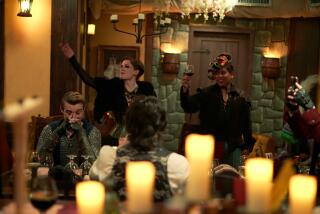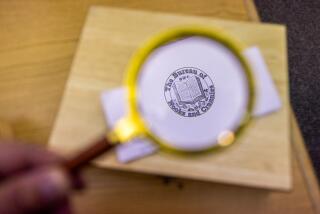Scary books: Read any good grimoires lately?
Thanks to their conspicuous use by Buffy the Vampire Slayer, the girls of the TV show “Charmed,” Elphaba in the Broadway musical “Wicked” and plenty of other prominent pop culture figures, grimoires have become far more familiar to the general public. In “Grimoires: A History of Magic Books” ( Oxford University Press: 368 pp., $29.95), Owen Davies traces their development and notes a democratic impulse in their spread helped by the creation of the printing press (thank you, Mr. Gutenberg).
Over many centuries, there have been countless magic books promising to help conjurers summon spirits. And among the many pleasures of reading Davies’ book is the simple, shiver-producing enjoyment of scanning the rich, ominous-sounding titles that he catalogs in the course of charting their historical development:
* “The Clavicule of Solomon”
* “The Black Pullet”
* “The Grimoire of Pope Honorius” (yes, that’s right, some Catholic clergy were said to dabble in the black arts. This book was popular in 18th century France -- one of its spells involved using a cat’s head to attain invisibility.)
* “Dragon Rouge” (shades of novelist Thomas Harris)
* “The Black Raven” (associated with the legendary Faust)
* “The Satanic Bible” (of Anton LaVey, who was a San Francisco-based sorcerer supreme in the 1960s and ‘70s)
The one title, though, that I sought in vain in Davies’ book was “The Book of the Vishanti.” Have you heard of this one? It is an extremely elusive text: Only one copy of the book is said to exist, and it is kept in the library of Stephen Strange, the great sorcerer from the house of Marvel Comics. Oh, OK. That must be the reason why I couldn’t find it.
And yet, “The Book of the Vishanti” was my first experience of a grimoire, spending summer days in the ‘70s in the smelly used bookstore around the corner. The owner didn’t care if I read everything cover to cover, and I’d spend hours reading copies of “Strange Tales,” “Daredevil” and “The Fantastic Four” as I tried to figure the best way of maximizing the five bucks in my pocket. That was when I encountered Dr. Strange, master of the occult arts, opening an enormous book and reciting a long, ominous incantation that would open a doorway from this world into another dimension:
In the name of the dread Dormammu,
In the name of the all-seeing Agamotto,
By the powers that dwell in the darkness,
I summon the hosts of Hoggoth!
Lead me to the source of evil!
Obey the words of Doctor Strange!
And then, in the next frame, a swirling cloud appears and takes the shape of a portal! The spell produces an instantaneous result.
After reading Davies, however, one sees a more serious implication in all this comic book playfulness: Here is a shadowy magician, a recluse; he possesses a secret knowledge; and there is that obscure, pretentious language in the book -- all suggestive of the exclusivity that Davies says the clergy and nobility wielded to keep power out of the hands of the people.
“The history of grimoires, as told in these pages, is not only about the significance of the book in human intellectual development,” he explains, “but also about the desire for knowledge and the enduring impulse to restrict and control it.”
And yet, despite their best efforts, many factors enabled these books and many others to spread and filter down the social ladder. Mentioned earlier, a big factor in the proliferation of grimoires was mass production enabled by the printing press (and, connected with this, traveling peddlers who sowed the populace with cheap copies).
Another factor Davies highlights has to do with basic human nature. Since the beginning of time, fears of illness and selfish desires -- for love, sex, fortunes -- nudged people to seek supernatural aid, whether from the communion of saints or from a circle of fiends. (In the case of fortunes, printed gacetas -- gazetteers -- showing the locations of buried treasures seemed to be as popular in Spain in the 18th and 19th centuries as maps of stars’ homes have been for tourists in Hollywood.)
Words, the author points out, have always been regarded as containing power -- real power, not just figurative power (the word “grimoire,” in fact, Davies says, is believed to be derived from a word for “grammar”). Peasants even wrote magical words on food given to cattle in the hopes that this would spare the animals from diseases that were blighting other herds. Magic was a necessary force in people’s lives, the author concludes, “which is why printers, at considerable risk, soon saw the market potential.”
“Grimoires” isn’t an analysis of magic rituals and how they work, though Davies discusses some practices and the gross ingredients they required. Mainly, he directs interested readers to other resources for this kind of information. There is, for example, Arthur Edward Waite’s book on occult practices, which is worth a look -- he strives to do for such practices what James Frazer did for anthropology in “The Golden Bough.” And if his last name seems vaguely familiar to you, that’s because he, along with artist Pamela Colman Smith, created the most popular version of Tarot cards around, the Rider-Waite-Smith deck (Rider, by the way, refers to the Rider Co. that published the deck).
His book does, however, provide an interesting, compelling survey of the many people who have contributed to the popularization of grimoires -- among them are Cornelius Agrippa, cunning-folk, con men, Joseph Smith (yes, the founder of the Church of Jesus Christ of Latter-day Saints), as well as novelists who have whetted the public’s appetite for arcana, including H.P. Lovecraft, J.K. Rowling, Arturo Pérez Reverte, Susanna Clarke and, no surprise, Dan Brown.
Though many people are fearful of these books, Davies’ conclusion is an optimistic one. He maintains, simply, that grimoires’ survival, and the Internet’s role now in giving “easy access to the magic that two millennia of censorship tried to suppress,” are less a sign of Luciferian menace at work than a triumph of individual freedoms and the liberty that enables one to read what one chooses.
Though the “Malleus Maleficarum” receives a fleeting mention -- just one -- in Davies’ survey, a comprehensive paperback edition is now available under the translated title “The Hammer of Witches,” translated and edited by Christopher S. Mackay ( Cambridge University Press: 658 pp., $29.99).
“The Hammer of Witches” is a grimoire of sorts, though “anti-grimoire” is probably a better way to describe it. According to Mackay in his introduction, the book first appeared in the 15th century in western Germany and was said to be the work of two inquisitors intent on compiling a manual on how to counteract the spells cast by sorceresses. That, he explains, is how it came to receive its title.
“The ‘Malleus Maleficarum’ is thus a hammer to be used to smash the conspiracy of sorceresses that was thought to be threatening the very existence of Christendom.”
In light of Davies’ argument in his book, this justification of the “Malleus” seems very modern: Many times in history a menacing conspiracy has been identified in order to justify the severe methods of suppressing it.
The “Malleus” is a fascinating mixture of theological and practical information. The first section demonstrates why one must hunt and persecute witches with lawyerly, Aquinas-like arguments and plenty of poetic flourishes, like this one that contrasts Lucifer with Jesus:
“[T]he Ancient Rising Sun, who was perverted through the ineluctable damage caused by his downfall, has never ceased, since the beginning, to taint the Church, which the New Rising Sun . . . has made fruitful through the shedding of His Own Blood.”
All of this is followed by sections on counter-spells and on interrogating suspected sorceresses that are disturbingly lacking in any regard for individual innocence. Among these later sections are “Ruses to Facilitate Confession” and “Methods of Passing Sentence if the Accused Is Found Not to Have Confessed but to Be Legally Convicted.” And then there is this one: “The Vulgar Form of Purgations and Especially the Examination by Glowing Iron, Which Sorceresses Appeal.”
These -- more than the other sections, I think -- should produce the biggest shivers of all in readers.
Next time: A talk with Michael Moorcock.
Nick Owchar’s “The Siren’s Call” appears monthly at www.latimes.com/books.
More to Read
The biggest entertainment stories
Get our big stories about Hollywood, film, television, music, arts, culture and more right in your inbox as soon as they publish.
You may occasionally receive promotional content from the Los Angeles Times.










